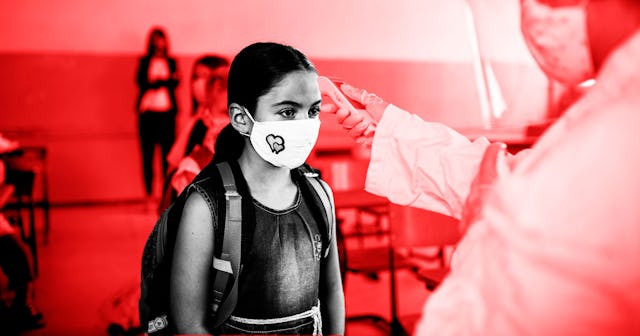Reopening Schools As COVID Variants Start To Spread? Nope

We keep saying it: reopening schools mid-pandemic is a terrible idea. Let’s think about that sentence for a moment. We are still in the grip of a global pandemic that has now killed more Americans than World War II. The IHME Model on COVID-19 predicts that we’re most likely to have 567,000 cumulative deaths by May 2021. In a “mandates easing” scenario,” which includes opening schools, we could see as many as 621,000 deaths: right about the same number as the Civil War (this includes disease, starvation, etc., and not merely combat deaths).
Yet here we are, talking about sending kids back to school with unvaccinated teachers as new variants emerge. And even if teachers were vaccinated, the vaccines don’t protect as well against those strains, which are more contagious. You’re screaming about generational problems in BIPOC communities — when Black and Latinx populations are 2.8 times more likely to die than white folks, with American Indian or Alaskan Natives not far behind. I have teacher friends who tell me of children who have lost grandparent after grandparent, aunt and uncles, and in one case, both parents.
I’d call “the trauma of losing your elders” a generational problem.
I’ll say it again: reopening while it feels like most of the country is a COVID-19 hotspot (South Carolina public schools are open in many places, and it’s the darkest state on the map) is a terrible idea.
Yes, The CDC Recommended Reopening, BUT…
Even Anthony Fauci, the federal government’s top infectious disease specialist, says that reopening all schools may not be possible by April because of the new COVID-19 variants. Yes, the CDC recommended reopening schools based on an article from the Journal of the American Medical Association. This article argued that in the vast majority of cases, there were no massive outbreaks like we’ve seen in nursing homes; however, there were some. Those happened in “crowded classrooms with insufficient physical distancing (e.g., student density in classrooms exceeded recommended values), exemption from face mask use, and continuous air conditioning that recycled interior air in closed rooms during a heat wave.”
Therefore, for reopening to happen safely, every classroom in America must be able to provide safe distancing, consistent and proper face mask usage, and adequate ventilation. And we know that’s not possible. Many schools are crowded already — and we’re faced with the virtual/hybrid model that has teachers stressed and parents (still) scrambling for babysitting. Sticking kids in daycare half-time only increases their possible COVID-19 exposure and defeats safety efforts.
We also know that most American schools lack proper ventilation. According to the National Education Association, a study by the U.S. Government and Accountability Office reported that to prevent COVID-19 spread, more than 41% of districts had to “update or replace” their HVAC systems in more than half of their buildings.
Do you see this happening? Because I don’t see this happening.
Yes, Karen, Kids Spread COVID-19 — And Variants Make That Scary
LeoPatrizi/Getty
Okay, let’s put this baby to rest. Kids spread COVID-19 — and spread it scarily. One study conducted by Massachusetts General Hospital and Massachusetts General Hospital for Children found that children, even asymptomatic kids, spew out as many viral particles as adults in ICU COVID-19 wards. One study in Physician’s Weekly found, moreover, that this viral shedding can possibly last for weeks, particularly in fecal matter, and kids aren’t exactly known for their cleanliness.
Clearly, children are capable of spreading COVID-19, though they are more likely to be asymptomatic (up to half of pediatric cases) and suffer less severe cases themselves, according to the CDC. Reopening schools because kids don’t spread the virus? Not a viable argument.
Then come the variants.
First, there’s the UK variant of COVID-19, according to the CDC. It has several mutations, and initial reports seem to show that it’s not only more contagious than other strains, but it’s also more deadly. We found it in the United States in 2020. There’s also the South African variant, which was first reported in the U.S. in January. Finally, there’s a third variant from Brazil, first detected at the end of January. That one’s the scariest: it “contains a set of additional mutations that may affect its ability to be recognized by antibodies.”
Then there’s the key phrase: “These variants seem to spread more easily and quickly than other variants.“
Kids + Variants + Reopening Schools = Bad Decision
So you want to reopen schools while the virus is not only still raging, but becoming more transmittable? As the CDC says, studies have shown that current vaccines seem to work, though not as well, on the new variants. This would be great — if teachers were vaccinated before reopening. Unfortunately, in too many cases, they aren’t (even those with preexisting conditions).
So unvaccinated teachers are sitting in classrooms with poor ventilation and more virulent strains of COVID-19. Students are more likely to contract COVID-19 and carry it home to elderly relatives — and those elderly relatives, especially if they’re BIPOC, are more likely to die. What’s more traumatizing, losing multiple family members to COVID-19 or missing your friends?
Yes: students have suffered from social isolation. That’s not in question. However, sending them to school, where they put their communities in more danger, isn’t the answer. We fret about children “being behind.” You can’t be behind when everyone’s behind. The bar changes. Expectations change. Can’t we offer children a hand up after the pandemic, rather than throwing our hands in the air and saying they’ve lost already?
To keep kids, faculty, staff, and communities healthy, we need to keep school closed until at least teachers and staff are fully vaccinated. That’s the lowest bar. Yes, it sucks. This will be known as The Lost Year, and we’ll all mourn it.
But we would mourn our dead more.
This article was originally published on